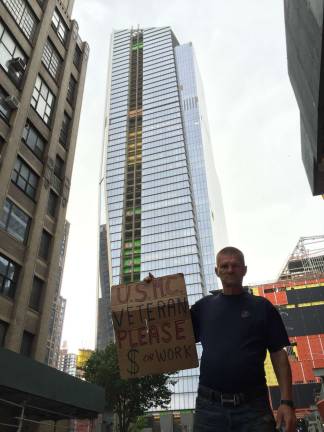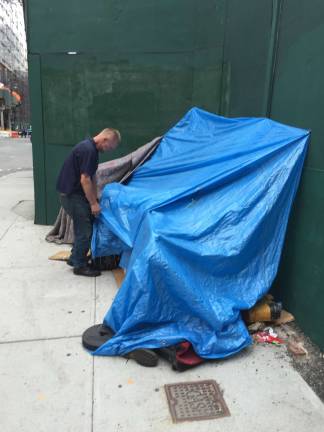living in a valley of glass


BY ISIDRO CAMACH0
Amid the cacophony of construction noise emanating from nearby Hudson Yards, a shirtless man sleepily walks out of a makeshift tent. He carries a sign that reads “U.S. Veteran Please $ or Work.”
His name is Larry Martin and he silently tucks a blue United States Marine Corps T-shirt into his jeans. He has deep lines set in his face from years spent outside in the sun. Still, Martin, though 60, remains fit and has a strong upright posture.
Martin has called the corner of 10th Avenue and 31st Street home for the past two years. He collects between $30 and $40 a day soliciting money from drivers inching into the Lincoln Tunnel nearby.
His tent rests flush within the corner of a wood-paneled construction wall. Martin used a blue plastic tarp, purchased for $5 from a local hardware store, and duct tape to build his “room,” which is cluttered with old clothes, cardboard — his makeshift mattress — and thick paperback books.
Reading is Martin’s preferred way of passing time. A suitcase weighs down one side of his tent. It nearly bursts open with yet more books.
Martin’s space lies between three separate “megadevelopment” sites: the nearly completed office tower at Hudson Yards, an adjacent five-story retail space and a residential building. The bulk of Hudson Yards is estimated to be completed by 2019. It will entirely transform the neighborhood from its industrial past.
The ongoing $4.5 billion Manhattan West project looms over Martin to the east. Luxury brands such as L’Oréal and Coach will soon have a foothold in the district. Developers envision a “city within a city.”
During his time on this corner, Martin has watched the Far West Side, as the neighborhood was long called, become bathed in scaffolding and pristine glass. He wakes each morning in the shadow of the Manhattan West building, which is undergoing a conforming glass façade facelift. He is confounded as to why a company would spend millions of dollars to build, only to affix glass to the building’s exterior.
When he first set up his tent in 2014, the area was relatively quieter — and didn’t extend skyward. The final portion of the High Line was still unopened to the public. The 10 Hudson Yards Tower was just 10 stories tall.
He chose this block because it seemed secluded and far away from other homeless people, who largely congregate around Madison Square Garden.
Now the area pulses with foot traffic. Martin easily sleeps and lives despite the dense fog of noise that rises from three sides. “If you live on the streets long enough you develop senses,” he said. He still manages to read in his tent during heavy construction’s peak hours. He also routinely rises early, before the building even begins. The development provides his daily life with a rhythm.
Martin said he suffers from PTSD, which, coupled to fierce alcoholism, launched him into homelessness three ago. He is now sober. He has made friends with some of the construction workers and can benefit from more people passing by his tent.
Martin refuses to live in a shelter because, he said, he enjoys the liberty that living on the street entails. He tried living in a shelter when he first became homeless, but felt restricted and generally did not trust anyone living there.
“I’m not going to fit into a square box,” he said. “I’m going to live.”
Martin estimated that his sign nets him about $400 a month. He has a waterproof, albeit just 10-foot-by-8-foot roof over his head and he has a daily routine. His rough features belie a warm personality.
His abode is in stark contrast to two megadevelopments overlooking the Hudson River. Though they will both be providing so-called “affordable” housing units, the two projects hope to attract people of a higher tax bracket both with lavish sky-rise apartments and high-end retail spaces.
Martin’s surroundings are gentrifying quickly. He admits that the “lease” for his spot is coming to a close.
“They will kick me out soon,” he said, adding that he’s having increasingly tense encounters with developers.
He said that while the construction workers and other working class folks were the most likely to give him a dollar or two, the more well-to-do were more likely to complain to the police about him.
For now, though, Hudson Yards remains home.
“I really have all I really need here,” he said.